Teacher's guide
Objectives
Think Ahead: Know the Risks of Substance Use is a program launched by Health Canada to talk about the risks of substance use to help youth make informed decisions.
This guide is intended to help educators facilitate their own in-class sessions.
It provides grade 11 and 12 teachers with guidance and resources to help students understand the risks of substance use (cannabis, alcohol and opioids), and how they can reduce those risks, while also encouraging them to learn and understand what’s best for their overall health.
Engaging youth
By working through the various steps in the guide, you can build your own Think Ahead: Know the Risks of Substance Use lesson to deliver fact-based information, lead thought-provoking activities, and encourage youth to protect themselves and those around them.
Talking with youth about substance use can be tricky! Here are ways to engage with youth to promote open and positive communication:
- Start by creating a safe space: acknowledge that what is discussed in the classroom will not make its way to parents or guardians and ask students to respect others and not discuss outside the classroom.
- Set clear boundaries: respect and judgement-free interactions are key to promoting open, positive discussions.
To learn more about talking with youth about substance use, see Talking with teenagers about drugs.
Planning a session
Estimated duration: Approximately 60–90 minutes
| Understand the risks of substance use | (15-25 mins) |
| Learn how to reduce the risks of substance use | (30-40 mins) |
| Engaging activity to test their learning | (15-25 mins) |
- Location: Your classroom. If you’re learning from home, encourage the youth to find an area in their home where they are comfortable.
- Technical requirements: This module is intended for educators to guide students through a classroom experience and optimized for desktop use. If viewed on mobile, it is recommended to use landscape view for best results. An accessibility toggle is available to adjust text size and layout on smaller mobile screens. You will need internet access and a projector or large monitor to share the module content for the class. Students with access to individual computer, tablet or mobile devices will be able to follow along and engage with the interactive content on their own screens.
Think Ahead: Know the Risks of Substance Use lesson guide
Before getting started, please ensure you have the following ready:
- The Think Ahead: Know the Risks of Substance Use slides are set up and visible to the students
- If possible, it is recommended that students have access to a computer or tablet device for engaging in the interactive activities
Additional resources to support this program:
Topics discussed include Canada’s opioids crisis, signs of an overdose, and naloxone. If you are unfamiliar with this substance, we recommend viewing the below resources. There is also an FAQ section below to help you prepare for any questions students may have.
For an overview on opioids, see:
- Opioids: What Are They?
- Signs of an opioid overdose (online activity)
- Naloxone: Save a Life (fact sheet)
For a list of comprehensive substance use resources, see Talking with teenagers about drugs.
Cannabis
What’s the difference between CBD and THC?
There are hundreds of chemicals found in cannabis. Over 100 of these are known as cannabinoids. These cannabinoids interact with cannabinoid receptors located across the brain and body, which cause the stereotypical effects of cannabis.
Delta-9-tetra-hydro-cannabinol, also known as THC, is the most researched cannabinoid and causes the feeling of being ‘high,’ along with a range of other effects including impaired memory, anxiety, hunger, paranoia, red eyes, dry mouth, and an increased heart rate. The greater the THC level, the greater the risk of experiencing these effects.
Cannabidiol, also known as CBD, is unlike THC in that it doesn’t produce a high. Less is known about CBD compared to THC, but there is evidence to suggest that CBD can help manage some medical conditions including, as an example, seizures in children (aka epilepsy). Though the effects of CBD are mostly unnoticeable, it can still carry risks.
It’s important to know that THC and CBD can both harm brain development, especially when used daily or almost daily.
Doesn’t cannabis help with certain health problems?
There is some evidence that cannabis can have potential therapeutic uses for some people. For example, Canadians have reported that they use it for things like ongoing, long-term pain, or nausea/vomiting from cancer treatment. While cannabis can be used by some people for their health problems, determining whether cannabis is appropriate to treat an individual’s symptoms can only be made through a discussion with a health care practitioner, such as a doctor. Like all drugs, cannabis can have side effects, even if used for medical purposes.
What are the effects of cannabis on mental health?
A person may use cannabis socially, to relax, or to cope with poor mental health but it’s important to understand the long-term risks. Cannabis use has not been found to improve mental health. In fact, daily or near daily cannabis use over time actually contributes to poorer mental health and can increase your chances of developing disorders related to anxiety and depression.
Long-term daily or near daily use can also negatively impact the brain’s dopamine system, which gives feelings of pleasure and joy. It can also make a person feel fatigued, low in mood, or unmotivated.
A person using cannabis frequently could also become dependent on cannabis, have more trouble regulating their emotions, and experience feelings of anxiety and depression more often.
In severe cases, cannabis use can also increase chances of experiencing psychosis and schizophrenia. These cases are more likely among people with a personal or family history of mental health disorders, particularly male teenagers and young adults.
Reducing or stopping cannabis use may reverse some of its effects and can help improve long-term mental health. Everyone’s response to cannabis differs, including how they respond to reducing or stopping cannabis. Seeking support from a loved one or a healthcare professional can help.
Are there types of cannabis that don’t get you high?
CBD is a cannabinoid that does not produce a high. However, it can still have an effect on your brain and still has risks.
Are topicals that have cannabis in them, like lip balm, hand cream and bath bombs, safe?
Some people may use cannabis topicals to manage pain, however, the medical effects and potential health risks of using topics are still unknown.
Is cannabis ok for adults?
Consuming cannabis has risks for everyone. The risks of consuming cannabis are greater for youth and young adults because their brains are not fully developed and therefore, they are more vulnerable to the negative effects of cannabis. It is best to delay the use of cannabis until after the brain fully develops. This happens around the age of 25.
How addictive is cannabis and is it difficult to quit?
A person can become dependent on cannabis over time, just like with other substances. Using cannabis daily or near daily increases the chances of developing cannabis dependence.
Symptoms of dependence include:
- thinking a lot about and craving cannabis;
- finding it hard to stop or reduce use;
- an increased tolerance to cannabis, meaning needing more to feel the same effects; and,
- feeling increasingly restless, moody or anxious when not using cannabis.
Teenagers are especially vulnerable to cannabis dependence because cannabis can interfere with brain development. Cannabis dependence can also increase tolerance to cannabis, meaning that a person becomes desensitized to some of its effects and may feel the need to use more cannabis in order to feel the way they want to feel.
Being addicted to cannabis can make life more difficult by making it harder to do schoolwork, maintain relationships with friends and family, or participate in activities such as sports.
Alcohol
What’s the difference between being drunk/intoxicated and alcohol poisoning?
When someone drinks too much alcohol on a single occasion, he/she can become intoxicated/drunk. This causes symptoms like impulsive behaviour, slurred speech, nausea and vomiting, or impaired memory.
However, as intoxication becomes more severe, it can turn into alcohol poisoning.
It can be hard to tell the difference, but the easiest way to check if a person needs medical attention is to know the CUPS signs:
- Cold and sweaty skin
- Unconscious
- Puking
- Slow/irregular breathing or heart rate.
If someone is showing any of these symptoms, and they are not responsive when you talk to or gently shake them, call for help (911 or your local emergency service), place them in the recovery position, and stay with them until help arrives.
How many drinks are considered to be binge drinking?
Binge drinking is when a person drinks too much alcohol on a single occasion (for example, over the course of one evening). The definition of binge drinking can vary, as the way alcohol impacts a person depends on lots of factors like:
- height and weight
- age and sex
- how much a person has eaten that day
- whether or not a person is dehydrated
Rather than focusing on how much is “binge drinking” it’s better to know that the risks of negative outcomes increase quickly when someone has more than 2 standard drinks on one occasion.
Opioids
Are opioids addictive?
Yes, opioids are addictive.
Substance use, including opioid use, is different for everyone and can be viewed on a spectrum with varying stages of benefits and harms. Since opioids can produce euphoria (the feeling of being “high”), they have the potential for higher-risk use and addiction.
When someone is affected by addiction, they crave the drug and continue using it despite its harmful effects. The drug becomes the focus of their feelings, thoughts, and activities.
Addiction causes changes to the brain that makes it extremely hard to stop using the drug, even if someone wants to. This is because the body gets used to a regular supply of the drug.
If someone has developed a drug dependency (physical condition), and stops taking it or lowers their dosage quickly, they may experience withdrawal symptoms. (Chills/Sweating,
Diarrhea/Nausea/Stomach Pain, Insomnia, Body Ache/Widespread or Increased Pain)
There is support available to help someone with substance use and addiction.
Addiction is not a choice, and recovery is possible.
If fentanyl cannot be identified through taste, sight, or smell, how can it be detected?
Fentanyl is very hard to detect, which is one reason that counterfeit pills or other illegal drugs are so dangerous. Some supervised consumption sites have drug-checking services to help detect fentanyl. Some people also use fentanyl test strips, but it’s important to know that they have limitations. They are not designed to check illegal drugs, and they don’t always detect other fentanyl-like drugs, such as carfentanil.
Is naloxone complicated to administer? Can I get a kit?
Naloxone is simple to administer. In Canada, there are two types of kits available: A nasal spray and an injection. The nasal spray is sprayed directly into the nose and the injectable is injected into any muscle in the body, like an arm or thigh.
Watch these videos to learn more: How to give naloxone spray and how to give a naloxone injection.
Naloxone can begin to take effect within 2 minutes. If a response to an initial dose is not seen within 2-3 minutes, subsequent doses can safely be given.
Naloxone only works if the person has opioids in their system. If in doubt, always give naloxone. It is safe to give to someone even if the person did not take an opioid. It is safe for all ages.
Naloxone kits are available at most pharmacies. You do not need a prescription. The minimum age to receive a kit varies by province and territory, simply ask your local pharmacist. You can also see where your province or territory offers them.
Miscellaneous
What are the risks of other illegal drugs, like cocaine?
Canada’s illegal drug supply has become tainted with powerful opioids, such as fentanyl and other drugs, like benzodiazepines (depressant) or xylazine (veterinary medication).
The increasing toxicity of illegal drugs means that people who consume them are at greater risk for overdose, other substance-related harms, and death.
If students have more questions, or you’d like to learn more about different types of substances, visit: https://www.canada.ca/en/health-canada/services/substance-use/controlled-illegal-drugs.html
Is it possible to use substances safely?
There are always risks when it comes to using substances and the best way to avoid harms from substances is not to use them. Substance use is different for everyone and should be looked at on a spectrum. The stages are:
- Non-use (abstinence)
- Beneficial use
- Lower-risk use
- Higher-risk use
- Addiction (substance use disorder)
All substances carry their own set of risks and potential harms, some unique to the substance. For example, cannabis poisoning in adults is not generally known to be fatal; however, using illegal drugs, like illegal opioids, is extremely risky and can lead to an overdose, and death. Understanding what those risks are will help make informed decisions and safer choices.
What are the signs of a substance use disorder?
Only a health care professional can diagnose someone with a substance use disorder, but there are signs that you can look out for:
Changed personality. A person struggling may isolate themselves, have extreme changes in their behaviour and mood, have trouble concentrating or remembering things, and lose interest in activities.
Changes in habits around their drug or alcohol use. They may use drugs first thing in the morning or at school, use more often and on their own, spend more money on drugs or alcohol, and try new drugs or mixing substances.
Difficulty managing basic parts of their life. They may get lower grades at school, miss days at school, have decreased health, strained relationships, and lower self-esteem.
What do I do if I think someone is showing signs of a substance use disorder?
If you are worried that someone in your life seems to be struggling with substance use, here are some tips: Starting a conversation can show you care and may encourage the person to seek help.
Here are some tips to help you talk with this person:
- Learn the facts about substances first, like effects and risks.
- Choose a good time and a private place to talk to them.
- Show concern and be compassionate.
- Listen and acknowledge their feelings.
- Avoid being judgmental.
- Respect where they are in their journey and know that the decision to seek help is up to them.
- Remind them, if it is relevant, that there are people around that love them and care about their well-being.
- Recognize their strengths.
Be patient, don’t rush the conversation and try to find a solution right away.
If they are ready, encourage them to call, visit, or read information online. You can even offer to go with them to seek help.
For more information: How to talk to a family member or friend about their drug or alcohol use.
How do people get addicted to substances? Can’t they just stop?
Addiction, or substance use disorder, is a medical condition that affects the brain. Someone may want to stop using substances but are unable to.
However, this condition is treatable. The type of treatment can vary depending on the circumstances and the substances used. Some options include medications, psychological support like therapy, withdrawal management, and peer support.
Teacher's notes legend
|
Pink text = directions for going through the module Black text = suggested notes to help interactions with students |

Teacher's Notes
What is ‘Think Ahead: Know the Risks of Substance Use’? It’s a program launched by Health Canada to talk about the risks of substance use to help youth like you make informed decisions.
You’ll also learn about signs of poisoning and overdose and what to do.
This program focuses on 3 specific substances: cannabis, alcohol and opioids. It also provides information about the risks of mixing or using more than one substance.

Teacher's Notes
Not sure about a word, or need a quick refresher on the substances in this module, refer to the glossary anytime!

Teacher's Notes
Prompt the class to engage in a discussion.
Do you know what the legal age is in our province for alcohol? What about cannabis?

Teacher's Notes
In-class discussion: start a conversation with students on the perception that legal substances are safe to use because they are legal. Ask students to look at the slide with the True or False question.

Teacher's Notes
Before we begin, I want everyone to know that this is a judgement-free space. I do not plan on bringing our conversations outside of this classroom, this will not make its way back to your family and I want to ask that you do the same for your peers as well.
For the first activity, let’s understand the risks of substance use and what to do to reduce them.

Teacher's Notes
In-class discussion: start a conversation about the first time students were exposed to substances, for example at school, with friends or even at family gatherings. Encourage, but don’t pressure, students to share stories.
Substances like alcohol, cannabis, opioids or other drugs are likely around you: in a social setting, at home or when hanging out with friends.

Teacher's Notes
Why do you think people use substances?
Prompt students to engage with the on-screen activity. Once the interaction is done, optional to discuss reasons for use.
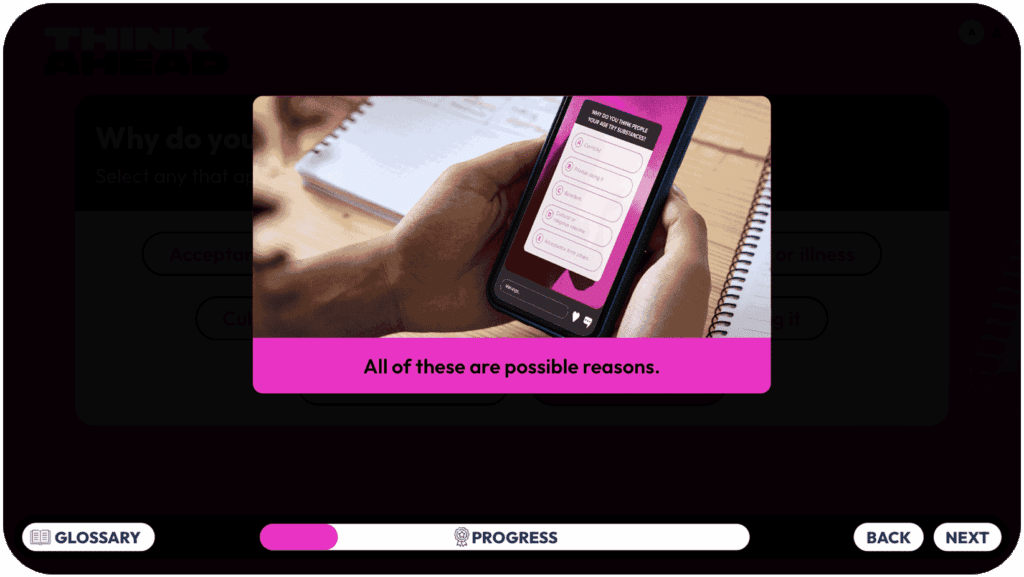
Teacher's Notes
All of these are possible reasons.
While some young people have tried substances, there are many who have not.
Can you think of other reasons why people use substances?

Teacher's Notes
Optional: lead students in a second in-class discussion.
Substance use comes with real risks. Can you think of any negative outcomes?

Teacher's Notes
There are negative outcomes from using substances. We’re going to look at a few now.

Teacher's Notes
Did you know? Everyone’s response to substances is different and can vary from one time to the next.
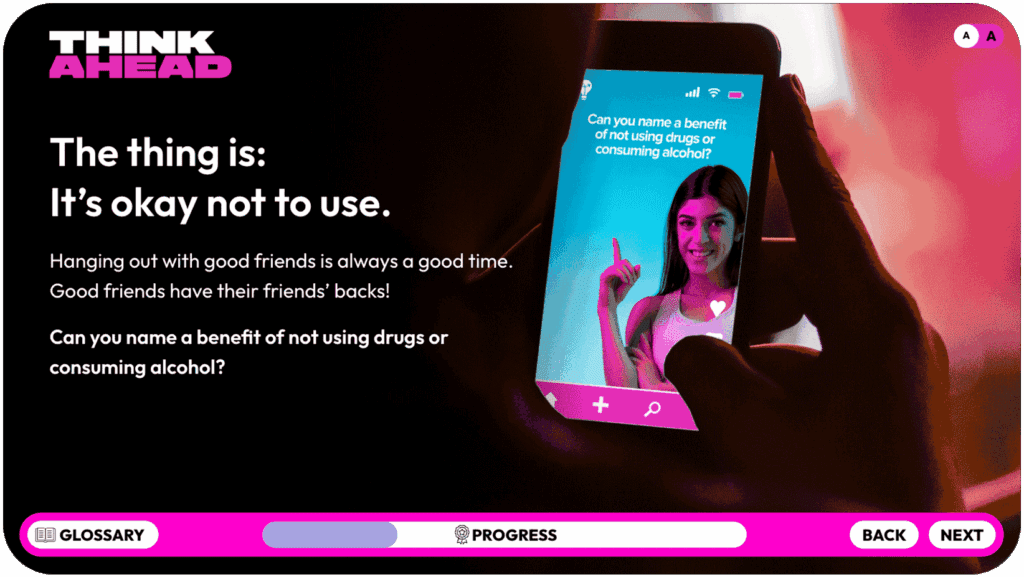
Teacher's Notes
Prompt students to think of perks of not using and ways to still have fun and feel included like non-alcoholic drinks, being the DD for your friends, feel great the next day, more energy, etc.
It’s okay not to use substances. Can you name some benefits of not using drugs or consuming alcohol?
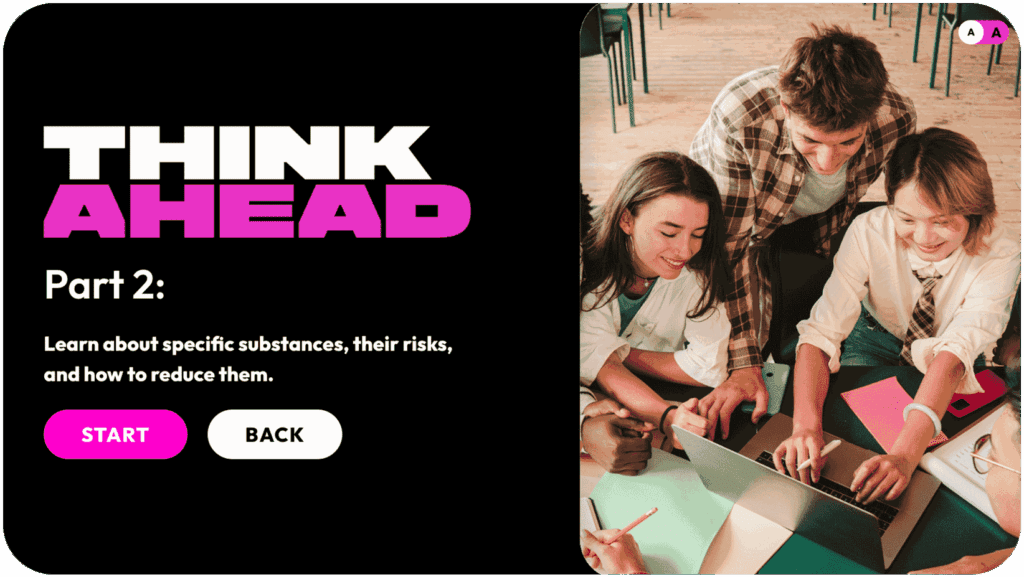
Teacher's Notes
Moving onto part 2: Let’s learn about some substances, their risks, and how to reduce them.

Teacher's Notes
This section is about cannabis.
After reading the fact, lead the students in an in-class discussion.
Is this surprising or new information for you?

Teacher's Notes
Prompt students to answer the question on-screen. Ask them to share their response before showing the next slide.
Until what age is your brain developing?

Teacher's Notes
Research shows that the brain is not fully developed until around the age of 25. So, using cannabis before this age can harm the way your brain develops and works.

Teacher's Notes
Have you heard of the term Greening Out?
Ask students if they are familiar with the term.

Teacher's Notes
Can you name symptoms of cannabis poisoning?
Prompt students to take the quiz on-screen.

Teacher's Notes
The symptoms of cannabis poisoning can include chest pain, rapid heartbeat, nausea/vomiting, psychotic episodes, severe anxiety and/or panic attacks.

Teacher's Notes
Let’s learn a bit more about cannabis and the risks with different methods of use. Take a look at the info on screen.
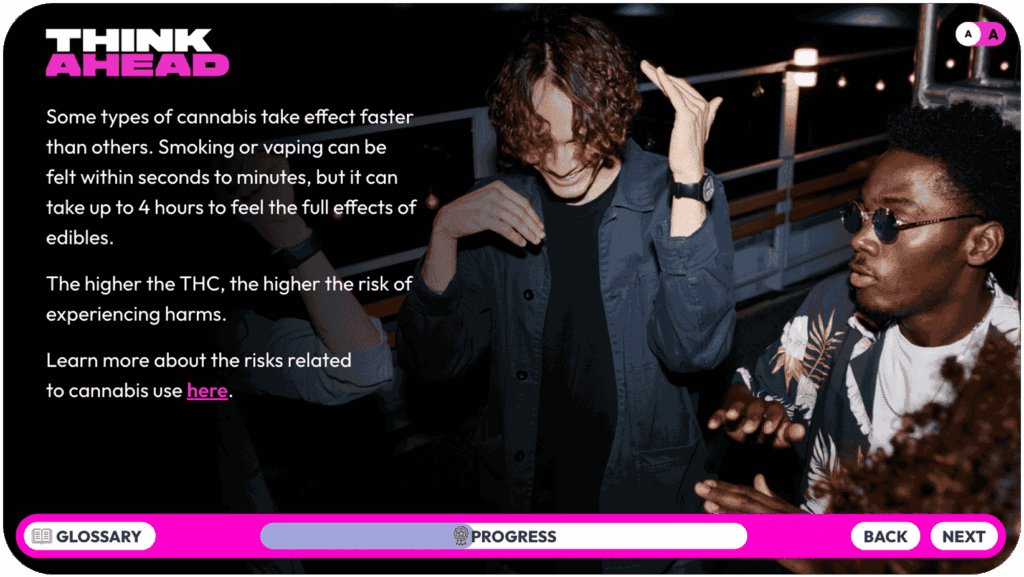
Teacher's Notes
You can learn more about the risks related to cannabis use at the page that is linked on screen.
Moving onto the differences between legal and illegal cannabis. Legal cannabis is quality controlled and tested, but illegal cannabis is not tested and may contain harmful levels of THC or contaminants like mould, bacteria, heavy metals and even pesticides!
How do you feel about knowing that illegal cannabis can contain those contaminants?
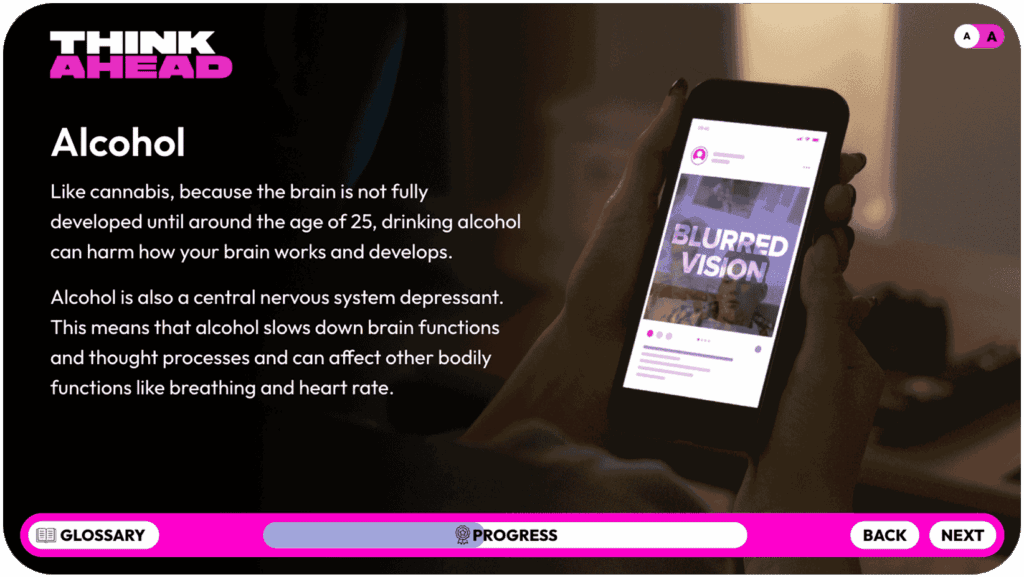
Teacher's Notes
Moving onto another substance that you may often find around you – alcohol.
Can you think of symptoms of alcohol intoxication?

Teacher's Notes
Severe intoxication can lead to alcohol poisoning, which is a medical emergency.
A helpful acronym for remembering common symptoms of alcohol poisoning is CUPS:
- Cold and sweaty skin
- Unconscious
- Puking
- Slow or irregular breathing and heart rate
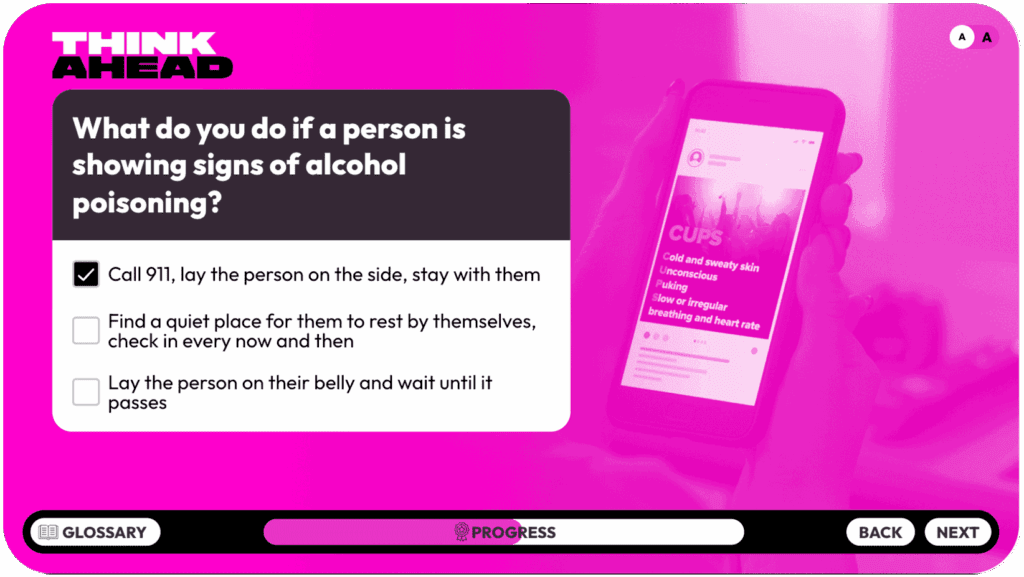
Teacher's Notes
Prompt students to take the quiz on-screen. Wait for students to answer before showing the next screen.
If you haven’t already, submit your answer for the anonymous quiz question.

Teacher's Notes
It’s the first option! If you see someone showing the CUPS signs, call 9-1-1, lay the person on their side, and stay with them until help arrives.
You can learn more about the risks related to alcohol use from the page linked on-screen.
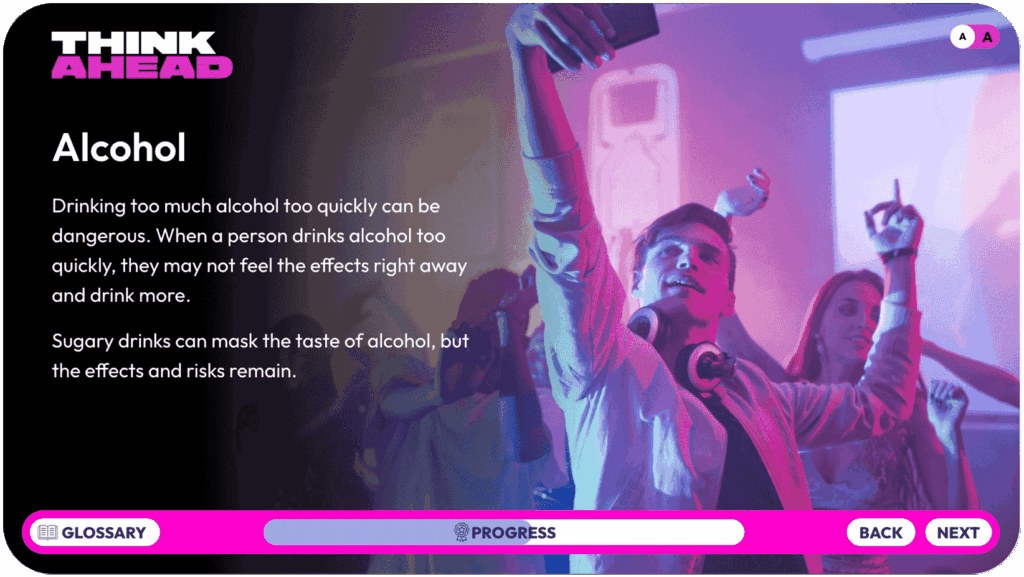
Teacher's Notes
Is this information new to you?
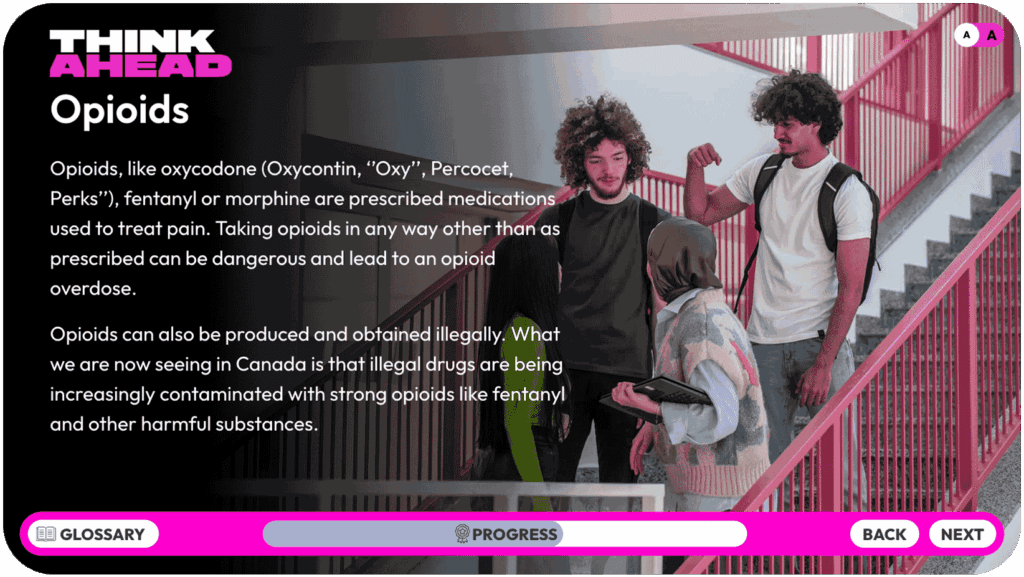
Teacher's Notes
Moving on to another substance: Opioids
Opioids are a type of drug usually used to treat pain. Legal opioids are prescribed by a health care professional and include medications like fentanyl, oxycodone, or morphine.
Illegal opioids are any opioids that are made, shared or sold illegally. They may be mixed in with other illegal drugs.

Teacher's Notes
It’s impossible to know what’s in counterfeit pills or other illegal drugs like cocaine, or how strong they are. Using illegal drugs, even just once, could cause an opioid overdose or death.
In-class interaction: Start a conversation by asking the class if they’ve heard about opioids like Fentanyl, Oxycodone (Oxycontin, ‘’Oxy’’, Percocet, ‘’Percs’’) or morphine. This could lead into a conversation about illegally produced opioids, how they are mixed with dangerous substances and can be fatal.

Teacher's Notes
Prompt students to take the quiz. Wait for students to answer before showing the next screen.

Teacher's Notes
The answer is none of the above.
You can’t see, taste or smell fentanyl, and a few grains can be enough to kill the average person. Fentanyl is 20 to 40 times more potent than heroin and 100 times more potent than morphine.

Teacher's Notes
It’s important to be aware of the effects of opioids, especially in case of an emergency. So, do you know what the symptoms of an opioid overdose are?
Wait for students to provide answers before showing the next screen with symptoms.
Take a look on screen to find out.
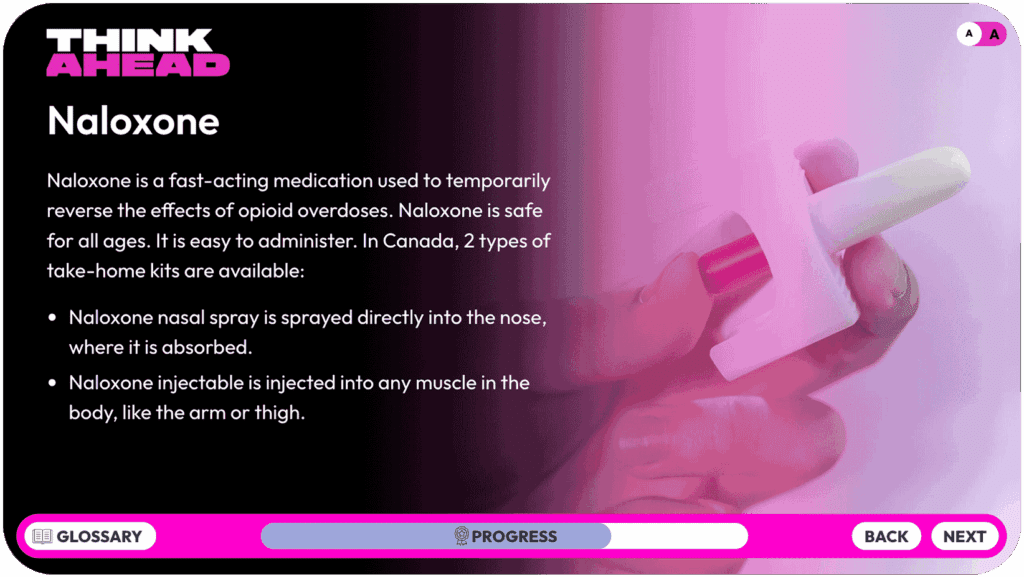
Teacher's Notes
In-class discussion: Begin a conversation by asking the class what naloxone is and if they’ve heard about it in the news, on the Internet, from a family member or friend.
Naloxone is a fast-acting medication used to temporarily reverse the effects of opioid overdoses.
Naloxone is safe for all ages. If someone shows signs of an opioid overdose, administer naloxone, even if you are unsure of the drugs taken. If there’s no response within 2-3 minutes, give another dose.
Here in Canada, there are two types of naloxone kits available. There is a nasal spray, sprayed directly into the nose, where it is absorbed. Then, there is an injectable, which is injected into any muscle in the body, like the arm or thigh.
If there are questions or a lot of interest in how they are used, you can show these videos.

Teacher's Notes
Most local pharmacies carry naloxone kits, and you don’t need a prescription. The minimum age to receive a kit varies by province and territory, simply ask your local pharmacist. Always carry a naloxone kit. It can save someone’s life in case of an overdose.
Don’t forget that naloxone only provides a temporary reversal of an opioid overdose. This means that the person still needs professional medical attention.
So, if someone is showing signs of an opioid overdose, call 9-1-1 first, then administer naloxone. Stay with the person until help arrives.

Teacher's Notes
Now, after learning about all this, we can look at the risks of combining substances.
Combining two or more substances is especially risky because the effects on the brain and body are unpredictable and can lead to severe intoxication, poisoning, drug overdose and, in some cases, death.
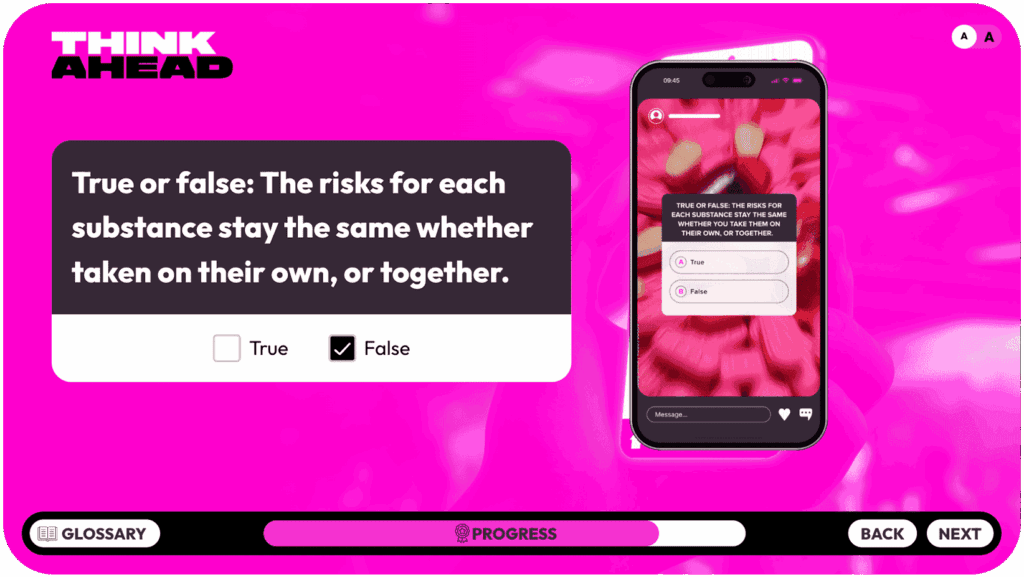
Teacher's Notes
Prompt students to take the quiz. If most students are confident, it’s false, ask them if they know why and what can happen.

Teacher's Notes
It is false. The risks to your physical and mental health increase when you combine two or more substances. The effects on the brain and body are unpredictable, and it could lead to severe intoxication, poisonings or overdoses.

Teacher's Notes
So, we’ve learned a lot about substance use today. It’s time to think ahead.
Your actions add up: Frequent substance use can contribute to poorer physical and mental health, and dependency.
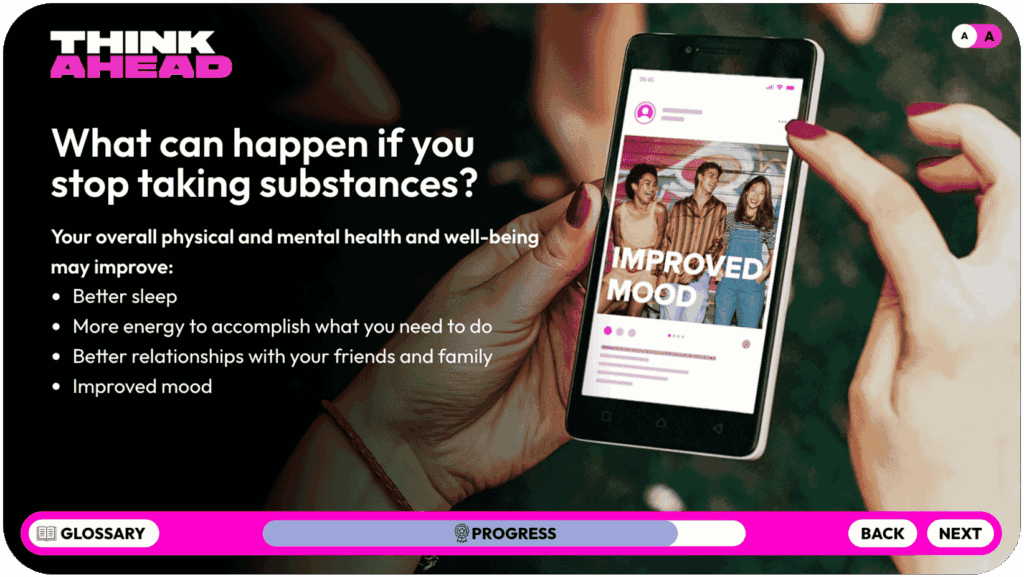
Teacher's Notes
If you decide that you won’t use substances, it can lead to a lot of benefits.
Take a look at the suggestions on the screen for some benefits that can happen when you don’t use substances.
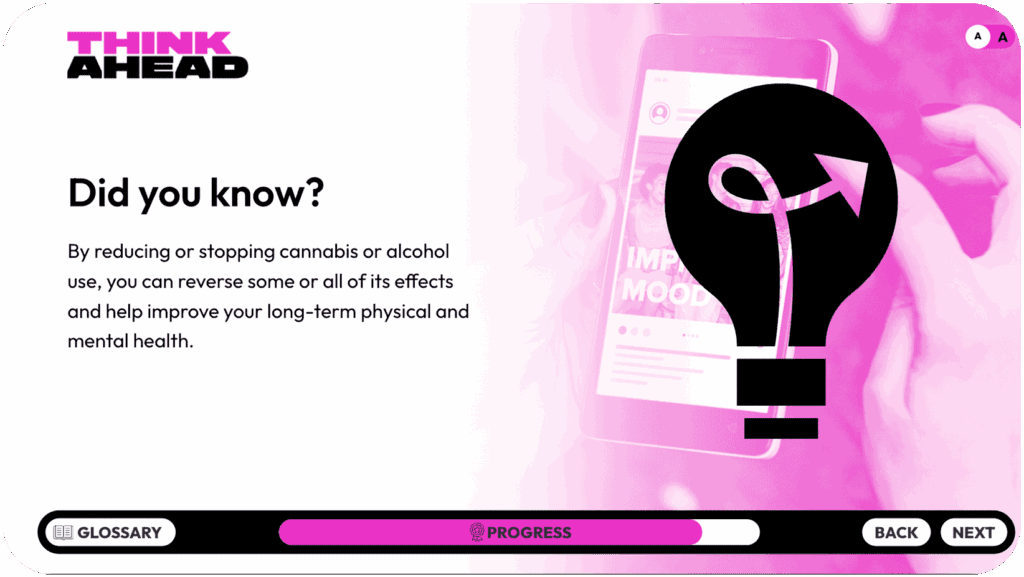
Teacher's Notes
Did you know? By reducing or stopping cannabis or alcohol use, you can reverse some or all of its effects and help improve your long-term physical and mental health.

Teacher's Notes
Now, let’s talk about how we can plan ahead and have an exit strategy in case you need one.
An exit strategy is a plan to help you leave a situation quickly if you feel you will be pressured to stay. Let’s start one together.
Hand out slips of paper or instruct them to open a note on their device.
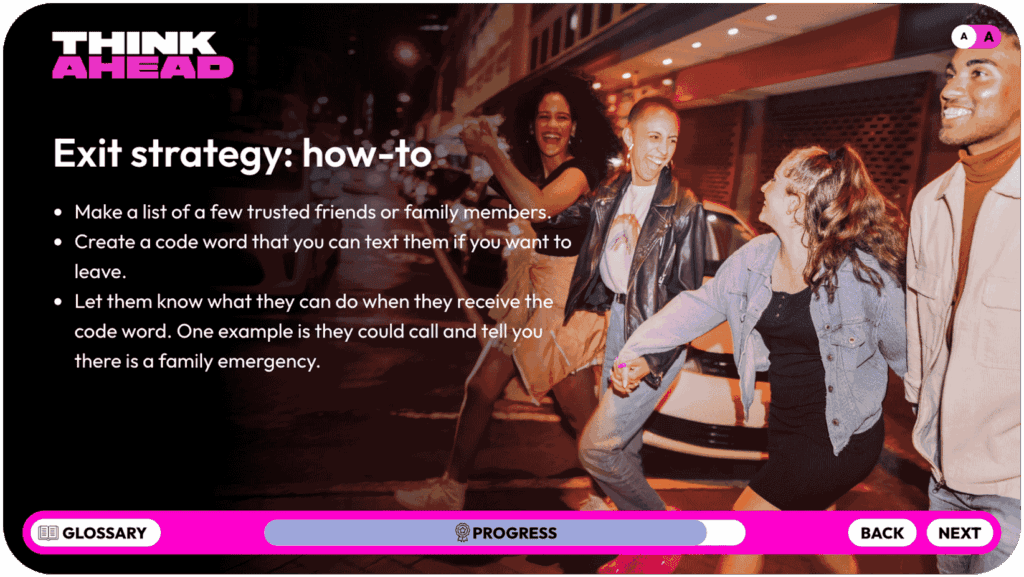
Teacher's Notes
First, think of a few trusted friends or family members in your life. Someone that you could call at any time to come and get you. Write down their names.
Then, create a code word that you will want to use to text them if you need to leave.
After school today, talk to the people that you’ve written down. Ask them if they would be your emergency contact and make a plan for what you would like them to do if you text them your code word.
Maybe there are substances around you when hanging out with friends or at a party, but you don’t want to leave. Having a plan for what you will say if someone offers you a substance can help. Does anyone have a go-to response?
Allow students to respond, then give examples that they didn’t cover, like the following:
- I have to get up early tomorrow, so I’m staying sober
- I don’t like the way [substance] makes me feel
- I’m driving tonight
- That’s just not my thing
- I have to study or work tomorrow
- I have practice or a game

Teacher's Notes

Teacher's Notes
Take a look at the checklist on-screen to get you started!
Have a conversation about which parts of the plan students like/would use and ask if they have anything to add.

Teacher's Notes
And that’s the most important thing, help is available! Reducing or stopping substance use can be difficult. Talk to someone you trust if you need help.
You can find out more and access the following services from the page linked on screen.
Frequently Asked Questions for Think Ahead: Know Your Risks module
Below are some questions that students may ask throughout your presentation. If students are looking for the meaning of a specific word, consult the glossary, which is available at the bottom of the screen anytime in the module.
What’s the difference between CBD and THC?
There are hundreds of chemicals found in cannabis. Over 100 of these are known as cannabinoids. These cannabinoids interact with cannabinoid receptors located across the brain and body, which cause the stereotypical effects of cannabis.
Delta-9-tetra-hydro-cannabinol, also known as THC, is the most researched cannabinoid and causes the feeling of being ‘high,’ along with a range of other effects including impaired memory, anxiety, hunger, paranoia, red eyes, dry mouth, and an increased heart rate. The greater the THC level, the greater the risk of experiencing these effects.
Cannabidiol, also known as CBD, is unlike THC in that it doesn’t produce a high. Less is known about CBD compared to THC, but there is evidence to suggest that CBD can help manage some medical conditions including, as an example, seizures in children (aka epilepsy). Though the effects of CBD are mostly unnoticeable, it can still carry risks.
It’s important to know that THC and CBD can both harm brain development, especially when used daily or almost daily.
Doesn’t cannabis help with certain health problems?
There is some evidence that cannabis can have potential therapeutic uses for some people. For example, Canadians have reported that they use it for things like ongoing, long-term pain, or nausea/vomiting from cancer treatment. While cannabis can be used by some people for their health problems, determining whether cannabis is appropriate to treat an individual’s symptoms can only be made through a discussion with a health care practitioner, such as a doctor. Like all drugs, cannabis can have side effects, even if used for medical purposes.
What are the effects of cannabis on mental health?
A person may use cannabis socially, to relax, or to cope with poor mental health but it’s important to understand the long-term risks. Cannabis use has not been found to improve mental health. In fact, daily or near daily cannabis use over time actually contributes to poorer mental health and can increase your chances of developing disorders related to anxiety and depression.
Long-term daily or near daily use can also negatively impact the brain’s dopamine system, which gives feelings of pleasure and joy. It can also make a person feel fatigued, low in mood, or unmotivated.
A person using cannabis frequently could also become dependent on cannabis, have more trouble regulating their emotions, and experience feelings of anxiety and depression more often.
In severe cases, cannabis use can also increase chances of experiencing psychosis and schizophrenia. These cases are more likely among people with a personal or family history of mental health disorders, particularly male teenagers and young adults.
Reducing or stopping cannabis use may reverse some of its effects and can help improve long-term mental health. Everyone’s response to cannabis differs, including how they respond to reducing or stopping cannabis. Seeking support from a loved one or a healthcare professional can help.
Are there types of cannabis that don’t get you high?
CBD is a cannabinoid that does not produce a high. However, it can still have an effect on your brain and still has risks.
Are topicals that have cannabis in them, like lip balm, hand cream and bath bombs, safe?
Some people may use cannabis topicals to manage pain, however, the medical effects and potential health risks of using topics are still unknown.
Is cannabis ok for adults?
Consuming cannabis has risks for everyone. The risks of consuming cannabis are greater for youth and young adults because their brains are not fully developed and therefore, they are more vulnerable to the negative effects of cannabis. It is best to delay the use of cannabis until after the brain fully develops. This happens around the age of 25.
How addictive is cannabis and is it difficult to quit?
A person can become dependent on cannabis over time, just like with other substances. Using cannabis daily or near daily increases the chances of developing cannabis dependence.
Symptoms of dependence include:
- thinking a lot about and craving cannabis;
- finding it hard to stop or reduce use;
- an increased tolerance to cannabis, meaning needing more to feel the same effects; and,
- feeling increasingly restless, moody or anxious when not using cannabis.
Teenagers are especially vulnerable to cannabis dependence because cannabis can interfere with brain development. Cannabis dependence can also increase tolerance to cannabis, meaning that a person becomes desensitized to some of its effects and may feel the need to use more cannabis in order to feel the way they want to feel.
Being addicted to cannabis can make life more difficult by making it harder to do schoolwork, maintain relationships with friends and family, or participate in activities such as sports.
What’s the difference between being drunk/intoxicated and alcohol poisoning?
When someone drinks too much alcohol on a single occasion, he/she can become intoxicated/drunk. This causes symptoms like impulsive behaviour, slurred speech, nausea and vomiting, or impaired memory.
However, as intoxication becomes more severe, it can turn into alcohol poisoning.
It can be hard to tell the difference, but the easiest way to check if a person needs medical attention is to know the CUPS signs:
- Cold and sweaty skin
- Unconscious
- Puking
- Slow/irregular breathing or heart rate.
If someone is showing any of these symptoms, and they are not responsive when you talk to or gently shake them, call for help (911 or your local emergency service), place them in the recovery position, and stay with them until help arrives.
How many drinks are considered to be binge drinking?
Binge drinking is when a person drinks too much alcohol on a single occasion (for example, over the course of one evening). The definition of binge drinking can vary, as the way alcohol impacts a person depends on lots of factors like:
- height and weight
- age and sex
- how much a person has eaten that day
- whether or not a person is dehydrated
Rather than focusing on how much is “binge drinking” it’s better to know that the risks of negative outcomes increase quickly when someone has more than 2 standard drinks on one occasion.
Are opioids addictive?
Yes, opioids are addictive.
Substance use, including opioid use, is different for everyone and can be viewed on a spectrum with varying stages of benefits and harms. Since opioids can produce euphoria (the feeling of being “high”), they have the potential for higher-risk use and addiction.
When someone is affected by addiction, they crave the drug and continue using it despite its harmful effects. The drug becomes the focus of their feelings, thoughts, and activities.
Addiction causes changes to the brain that makes it extremely hard to stop using the drug, even if someone wants to. This is because the body gets used to a regular supply of the drug.
If someone has developed a drug dependency (physical condition), and stops taking it or lowers their dosage quickly, they may experience withdrawal symptoms (Chills/Sweating, Diarrhea/Nausea/Stomach Pain, Insomnia, Body Ache/Widespread or Increased Pain).
There is support available to help someone with substance use and addiction.
Addiction is not a choice, and recovery is possible.
If fentanyl cannot be identified through taste, sight, or smell, how can it be detected?
Fentanyl is very hard to detect, which is one reason that counterfeit pills or other illegal drugs are so dangerous. Some supervised consumption sites have drug-checking services to help detect fentanyl. Some people also use fentanyl test strips, but it’s important to know that they have limitations. They are not designed to check illegal drugs, and they don’t always detect other fentanyl-like drugs, such as carfentanil.
Is naloxone complicated to administer? Can I get a kit?
Naloxone is simple to administer. In Canada, there are two types of kits available: A nasal spray and an injection. The nasal spray is sprayed directly into the nose and the injectable is injected into any muscle in the body, like an arm or thigh.
Watch these videos to learn more: How to give naloxone spray and how to give a naloxone injection.
Naloxone can begin to take effect within 2 minutes. If a response to an initial dose is not seen within 2-3 minutes, subsequent doses can safely be given.
Naloxone only works if the person has opioids in their system. If in doubt, always give naloxone. It is safe to give to someone even if the person did not take an opioid. It is safe for all ages.
Naloxone kits are available at most pharmacies. You do not need a prescription. The minimum age to receive a kit varies by province and territory, simply ask your local pharmacist. You can also see where your province or territory offers them.
What are the risks of other illegal drugs, like cocaine?
Canada’s illegal drug supply has become tainted with powerful opioids, such as fentanyl and other drugs, like benzodiazepines (depressant) or xylazine (veterinary medication).
The increasing toxicity of illegal drugs means that people who consume them are at greater risk for overdose, other substance-related harms, and death.
If students have more questions, or you’d like to learn more about different types of substances, visit: https://www.canada.ca/en/health-canada/services/substance-use/controlled-illegal-drugs.html
Is it possible to use substances safely?
There are always risks when it comes to using substances and the best way to avoid harms from substances is not to use them. Substance use is different for everyone and should be looked at on a spectrum. The stages are:
- Non-use (abstinence)
- Beneficial use
- Lower-risk use
- Higher-risk use
- Addiction (substance use disorder)
All substances carry their own set of risks and potential harms, some unique to the substance. For example, cannabis poisoning in adults is not generally known to be fatal; however, using illegal drugs, like illegal opioids, is extremely risky and can lead to an overdose, and death. Understanding what those risks are will help make informed decisions and safer choices.
What are the signs of a substance use disorder?
Only a health care professional can diagnose someone with a substance use disorder, but there are signs that you can look out for:
Changed personality. A person struggling may isolate themselves, have extreme changes in their behaviour and mood, have trouble concentrating or remembering things, and lose interest in activities.
Changes in habits around their drug or alcohol use. They may use drugs first thing in the morning or at school, use more often and on their own, spend more money on drugs or alcohol, and try new drugs or mixing substances.
Difficulty managing basic parts of their life. They may get lower grades at school, miss days at school, have decreased health, strained relationships, and lower self-esteem.
What do I do if I think someone is showing signs of a substance use disorder?
If you are worried that someone in your life seems to be struggling with substance use, here are some tips: Starting a conversation can show you care and may encourage the person to seek help.
Here are some tips to help you talk with this person:
- Learn the facts about substances first, like effects and risks.
- Choose a good time and a private place to talk to them.
- Show concern and be compassionate.
- Listen and acknowledge their feelings.
- Avoid being judgmental.
- Respect where they are in their journey and know that the decision to seek help is up to them.
- Remind them, if it is relevant, that there are people around that love them and care about their well-being.
- Recognize their strengths.
Be patient, don’t rush the conversation and try to find a solution right away.
If they are ready, encourage them to call, visit, or read information online. You can even offer to go with them to seek help.
For more information: How to talk to a family member or friend about their drug or alcohol use.
How do people get addicted to substances? Can’t they just stop?
Addiction, or substance use disorder, is a medical condition that affects the brain. Someone may want to stop using substances but are unable to.
However, this condition is treatable. The type of treatment can vary depending on the circumstances and the substances used. Some options include medications, psychological support like therapy, withdrawal management, and peer support.
Downloadable version
Legend:
- Pink text = directions for going through the module
- Black text = suggested notes to help interactions with students

